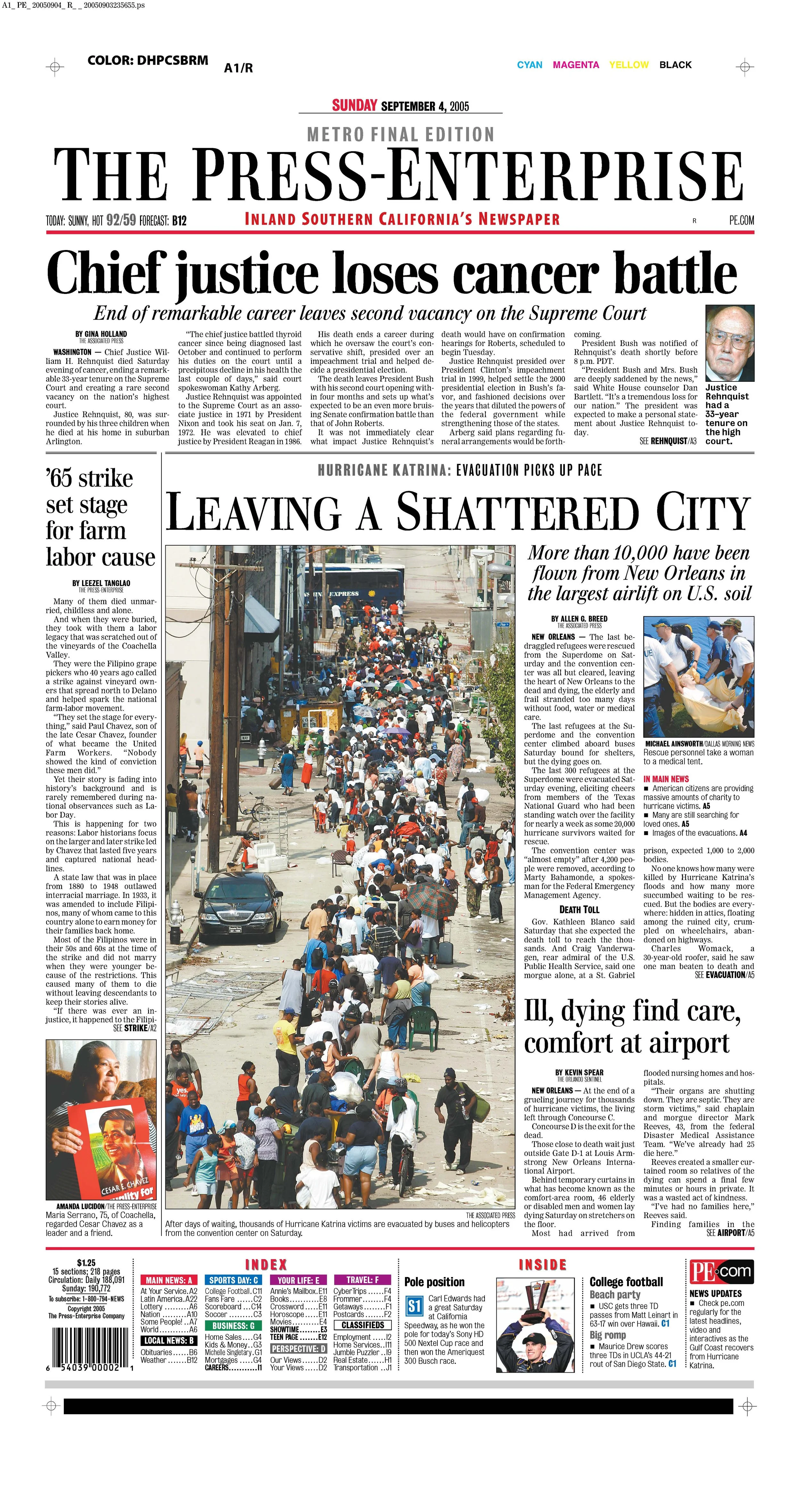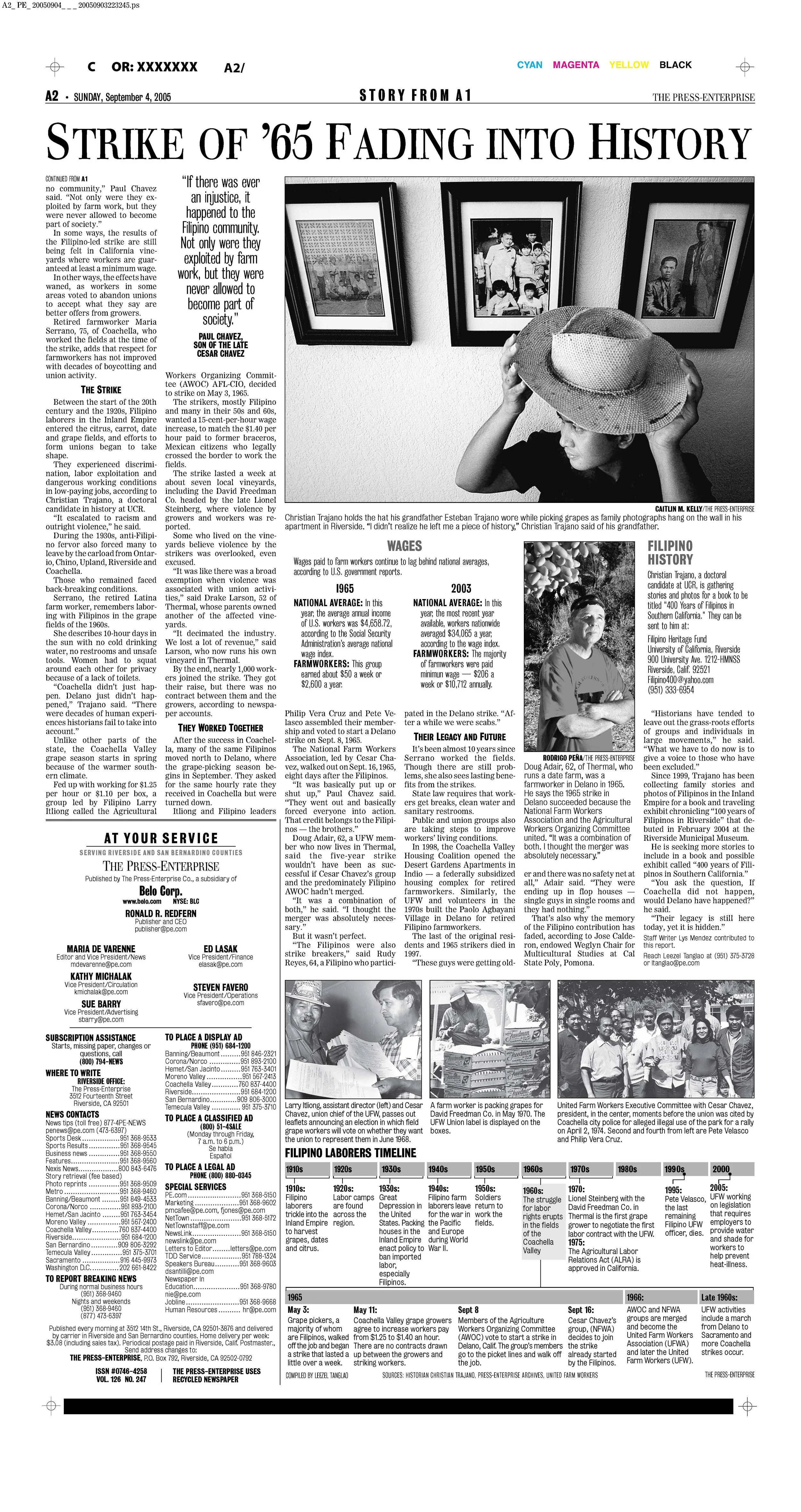September 4, 2005 | Press-Enterprise, The (Riverside, CA) | LEEZEL TANGLAO | Page A01
Many of them died unmarried, childless and alone.
And when they were buried, they took with them a labor legacy that was scratched out of the vineyards of the Coachella Valley.
They were the Filipino grape pickers who 40 years ago called a strike against vineyard owners that spread north to Delano and helped spark the national farm-labor movement.
"They set the stage for everything," said Paul Chavez, son of the late Cesar Chavez, founder of what became the United Farm Workers. "Nobody showed the kind of conviction these men did."
Yet their story is fading into history's background and is rarely remembered during national observances such as Labor Day.
This is happening for two reasons: Labor historians focus on the larger and later strike led by Chavez that lasted five years and captured national headlines.
A state law that was in place from 1880 to 1948 outlawed interracial marriage. In 1933, it was amended to include Filipinos, many of whom came to this country alone to earn money for their families back home.
Most of the Filipinos were in their 50s and 60s at the time of the strike and did not marry when they were younger because of the restrictions. This caused many of them to die without leaving descendants to keep their stories alive.
"If there was ever an injustice, it happened to the Filipino community," Paul Chavez said. "Not only were they exploited by farm work, but they were never allowed to become part of society."
In some ways, the results of the Filipino-led strike are still being felt in California vineyards where workers are guaranteed at least a minimum wage.
In other ways, the effects have waned, as workers in some areas voted to abandon unions to accept what they say are better offers from growers.
Retired farmworker Maria Serrano, 75, of Coachella, who worked the fields at the time of the strike, adds that respect for farmworkers has not improved with decades of boycotting and union activity.
THE STRIKE
Between the start of the 20th century and the 1920s, Filipino laborers in the Inland Empire entered the citrus, carrot, date and grape fields, and efforts to form unions began to take shape.
They experienced discrimination, labor exploitation and dangerous working conditions in low-paying jobs, according to Christian T rajano, a doctoral candidate in history at UCR.
"It escalated to racism and outright violence," he said.
During the 1930s, anti-Filipino fervor also forced many to leave by the carload from Ontario, Chino, Upland, Riverside and Coachella.
Those who remained faced back-breaking conditions.
Serrano, the retired Latina farm worker, remembers laboring with Filipinos in the grape fields of the 1960s.
She describes 10-hour days in the sun with no cold drinking water, no restrooms and unsafe tools.
Women had to squat around each other for privacy because of a lack of toilets.
"Coachella didn't just happen. Delano just didn't happened," T rajano said. "There were decades of human experiences historians fail to take into account."
Unlike other parts of the state, the Coachella Valley grape season starts in spring because of the warmer southern climate.
Fed up with working for $1.25 per hour or $1.10 per box, a group led by Filipino Larry Itliong called the Agricultural Workers Organizing Committee (AWOC) AFL-CIO, decided to strike on May 3, 1965.
The strikers, mostly Filipino and many in their 50s and 60s, wanted a 15-cent-per-hour wage increase, to match the $1.40 per hour paid to former braceros, Mexican citizens who legally crossed the border to work the fields.
The strike lasted a week at about seven local vineyards, including the David Freedman Co. headed by the late Lionel Steinberg, where violence by growers and workers was reported.
Some who lived on the vineyards believe violence by the strikers was overlooked, even excused.
"It was like there was a broad exemption when violence was associated with union activities," said
Drake Larson, 52 of Thermal, whose parents owned another of the affected vineyards.
"It decimated the industry. We lost a lot of revenue," said Larson, who now runs his own vineyard in Thermal.
By the end, nearly 1,000 workers joined the strike. They got their raise, but there was no contract between them and the growers, according to newspaper accounts.
THEY WORKED TOGETHER
After the success in Coachella, many of the same Filipinos moved north to Delano, where the grape-picking season begins in September. They asked for the same hourly rate they received in Coachella but were turned down.
Itliong and Filipino leaders Philip Vera Cruz and Pete Velasco assembled their membership and voted to start a Delano strike on Sept. 8, 1965.
The National Farm Workers Association, led by Cesar Chavez, walked out on Sept. 16, 1965, eight days after the Filipinos.
"It was basically put up or shut up," Paul Chavez said. "They went out and basically forced everyone into action. That credit belongs to the Filipinos - the brothers."
Doug Adair, 62, a UFW member who now lives in Thermal, said the five-year strike wouldn't have been as successful if Cesar Chavez's group and the predominately Filipino AWOC hadn't merged.
"It was a combination of both," he said. "I thought the merger was absolutely necessary."
But it wasn't perfect.
"The Filipinos were also strike breakers," said Rudy Reyes, 64, a Filipino who participated in the Delano strike. "After a while we were scabs."
THEIR LEGACY AND FUTURE
It's been almost 10 years since Serrano worked the fields. Though there are still problems, she also sees lasting benefits from the strikes.
State law requires that workers get breaks, clean water and sanitary restrooms.
Public and union groups also are taking steps to improve workers' living conditions.
In 1998, the Coachella Valley Housing Coalition opened the Desert Gardens Apartments in Indio - a federally subsidized housing complex for retired farmworkers. Similarly, the UFW and volunteers in the 1970s built the Paolo Agbayani Village in Delano for retired Filipino farmworkers.
The last of the original residents and 1965 strikers died in 1997.
"These guys were getting older and there was no safety net at all," Adair said. "They were ending up in flop houses - single guys in single rooms and they had nothing."
That's also why the memory of the Filipino contribution has faded, according to Jose Calderon, endowed Weglyn Chair for Multicultural Studies at Cal State Poly, Pomona.
"Historians have tended to leave out the grass-roots efforts of groups and individuals in large movements," he said. "What we have to do now is to give a voice to those who have been excluded."
Since 1999, T rajano has been collecting family stories and photos of Filipinos in the Inland Empire for a book and traveling exhibit chronicling "100 years of Filipinos in Riverside" that debuted in February 2004 at the Riverside Municipal Museum.
He is seeking more stories to include in a book and possible exhibit called "400 years of Filipinos in Southern California."
"You ask the question, If Coachella did not happen, would Delano have happened?" he said.
"Their legacy is still here today, yet it is hidden."
* * *
Staff Writer Lys Mendez contributed to this report.
* * *
WAGES
Wages paid to farm workers continue to lag behind national averages, according to U.S.
government reports.
I965
NATIONAL AVERAGE: In this year, the average annual income of U.S. workers was $4,658.72, according to the Social Security Administration's average national wage index.
FARMWORKERS: This group earned about $50 a week or $2,600 a year.
2003
National Average: In this year, the most recent year available, workers nationwide averaged $34,065 a year, according to the wage index.
Farmworkers: The majority of farmworkers were paid minimun wage - $206 a week or $10,712 annually.
* * *
FILIPINO HISTORY
Christian T rajano, a doctoral candidate at UCR, is gathering stories and photos for a book to be titled "400 Years of Filipinos in Southern California." They can be sent to him at:
Filipino Heritage Fund
University of California, Riverside
900 University Ave. 1212-HMNSS
Riverside, Calif. 92521
Filipino400@yahoo.com
(951) 333-6954
* * *
FILIPINO LABORERS TIMELINE
1910s
1910: Filipino laborers trickle into the Inland Empire to harvest grapes, dates and citrus.
1920s
1920: Labor camps are found across the region
1930s
1930s: Great Depression in the United States. Packing houses in the Inland Empire enact policy to
ban imported labor, especially Filipinos.
1940s
1940s: Filipino farm laborers leave for the war in the Pacific and Europe during World War II.
1950s
1950s: Soldiers return to work the fields.
1960s
1960s: The struggle for labor rights erupts in the fields of the Coachella Valley
1965
May 3: Grape pickers, a majority of whom are Filipinos, walked off the job and began a strike that lasted a little over a week.
May 11: Coachella Valley grape growers agree to increase workers pay from $1.25 to $1.40 an hour. There are no contracts drawn up between the growers and striking workers.
Sept. 8 Members of the Agriculture Workers Organizing Committee (AWOC) vote to start a strike in Delano, Calif. The group's members go to the picket lines and walk off the job.
Sept. 16: Cesar Chavez's group, (NFWA) decides to join the strike already started by the Filipinos.
1966: AWOC and NFWA groups are merged and become the United Farm Workers Association (UFWA) and later the United Farm Workers (UFW).
Late 1960s: UFW activities include a march from Delano to Sacramento and more Coachella strikes occur.
1970s
1970: Lionel Steinberg with the David Freedman Co. in Thermal is the first grape grower to negotiate the first labor contract with the UFW.
1975: The Agricultural Labor Relations Act (ALRA) is approved in California.
1990s
1995: Pete Velasco, the last remaining Filipino UFW officer, dies.
2000
2005: UFW working on legislation that requires employers to provide water and shade for workers to help prevent heat-illness.
COMPILED BY LEEZEL TANGLAO
SOURCES: HISTORIAN CHRIST IAN TRAJANO, PRESS-ENTERPRISE ARCHIVES, UNITED FARM
WORKERS
THE PRESS-ENTERPRISE
This is by far one of my most impactful story of my 20+ year career.
This story was awarded 1st place for Best Cultural/Diversity story with 50K+ circulation for the story “65 Strike Set Stage for Farm Labor Cause” from Society of Professional Journalists Inland Southern California Chapter in 2006.
If you search for this story, my byline no longer appears if you come across the online version on the new Press-Enterprise domain. But it is on archives like NewsBank: https://bit.ly/65strike
Please Cite: Tanglao, Leezel. ’65 Strike Set Stage for Farm Labor Cause. The Press-Enterprise, 4 Sept. 2005.
I reconnected with Paul Chavez and Doug Adair at Philippine Weekend festival in Delano, California on October 19, 2024. It was also the 50th anniversary of the Agbayani Village. I interviewed Paul and Doug in 2005.




